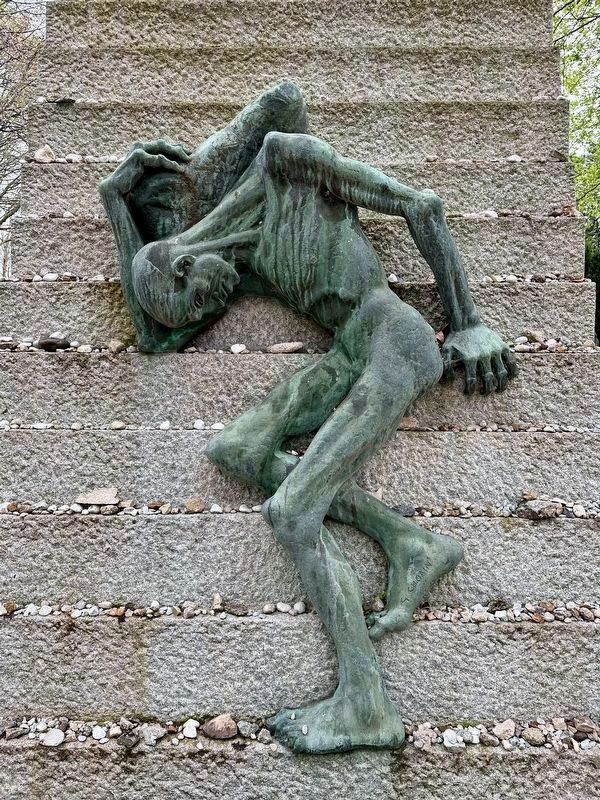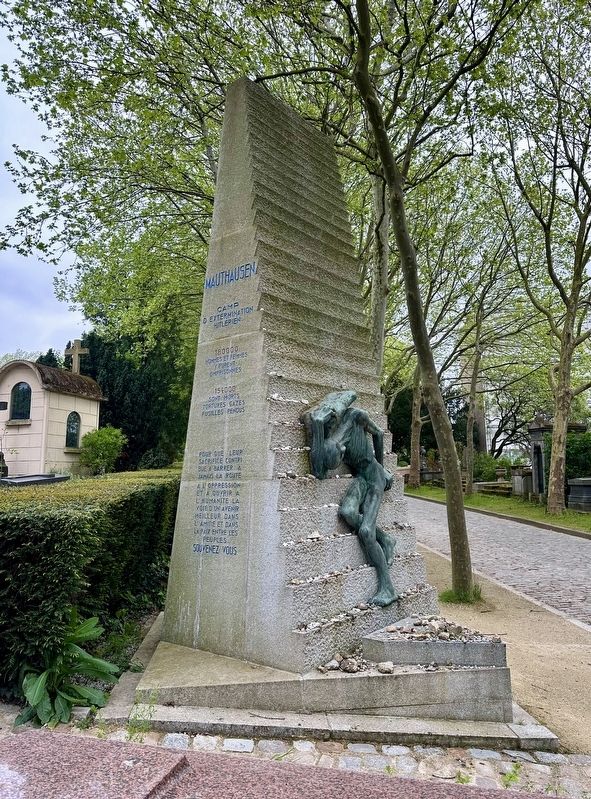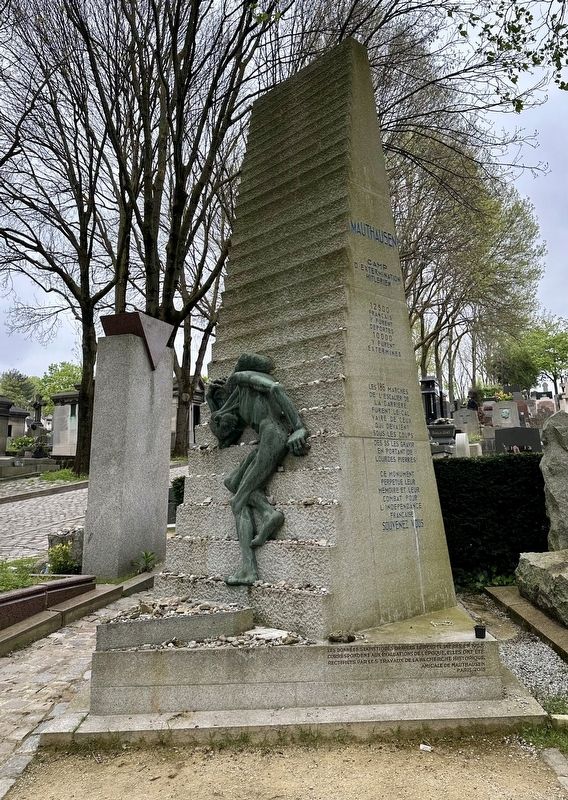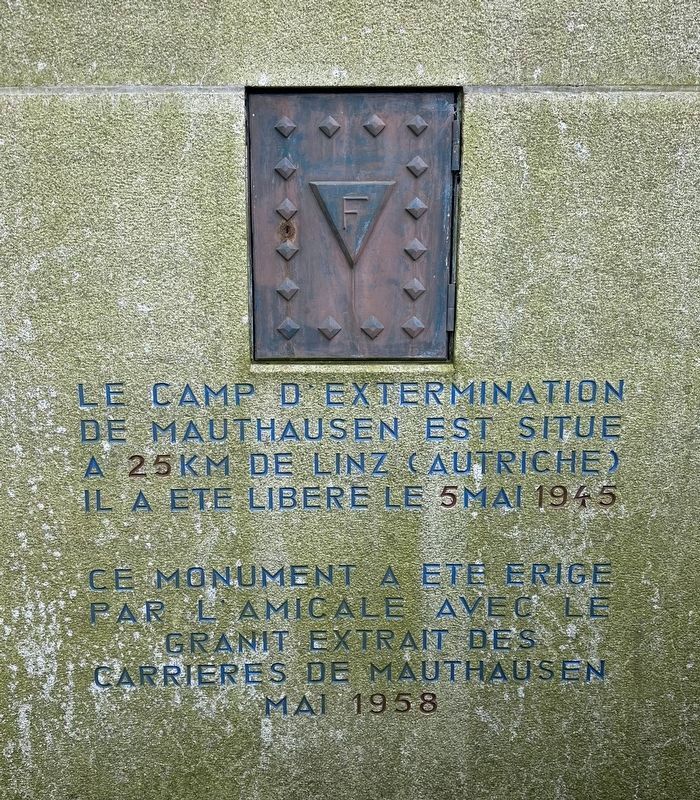Père-Lachaise in Paris in Département de Paris, Île-de-France, France — Western Europe
Mauthausen Concentration Camp Memorial
Camp d’extermination hitlerien
180000 hommes et femmes y furent emprisonnes
154000 sont morts tortures gazes fusilles pendus
Pour que leur sacrifice contribue a barrer a jamais la route al oppression et a ouvrir a l humanite la voie d’un avenir meilleur dans l’amitie et dans la paix entre les peuples
Souvenez vous
Mauthausen
Camp d’extermination hitlerien
12500 francais furent deportes
10000 y furent extermines
les 186 marches de l'escalier de la carriere furent le calvaire de ceux qui devaient sous les coups des ss les gravir en portant de lourdes pierres
Ce monument perpetue leur memoire et leur combat pour l’independance francaise
Souvenez vous
Le camp d’extermination de Mauthausen est situe a 25km de Linz (Autriche) il a ete libere le 5 mai 1945
Ce monument a ete erige par l'amicale avec le granit extrait des carrieres de Mauthausen mai 1958
Mauthausen
Nazi extermination camp
180,000 men and women were imprisoned there
154,000 died through torture, gassing, shooting, and hanging
So that their sacrifice contributes to forever blocking the road to oppression and to opening for humanity the path to a better future in friendship and peace between peoples - Remember them!
Mauthausen
Nazi extermination camp
12,500 French people were deported
10,000 were exterminated there
The 186 steps of the quarry staircase were the ordeal of those who, under the blows of the SS, had to climb them carrying heavy stones
This monument perpetuates their memory and their fight for French independence - Remember them!
The Mauthausen extermination camp is located 25km from Linz (Austria) and was liberated on May 5, 1945.
This monument was erected by the association with granite extracted from the Mauthausen quarries in May 1958.
Erected 1958.
Topics and series. This memorial is listed in this topic list: War, World II. In addition, it is included in the The Holocaust series list. A significant historical date for this entry is May 5, 1945.
Location. 48° 51.562′ N, 2° 23.946′ E. Marker is in Paris, Île-de-France, in Département de Paris. It is in Père-Lachaise. Memorial is at the intersection of Avenue Circulaire and Avenue Traversale No. 3, on the left when traveling east on Avenue Circulaire. The memorial is in Père Lachaise Cemetery in Section 77 on Avenue Traversale No. 3 right where it intersects Avenue Circulaire. Touch for map. Marker is in this post office area: Paris, Île-de-France 75020, France. Touch for directions.
Other nearby markers. At least 8 other markers are within walking distance of this marker. Flossenbürg Concentration Camp Memorial (here, next to this marker); Neuengamme Concentration Camp Memorial (within shouting distance of this marker); Maurice Audin (within shouting distance of this marker); Ravensbruck Concentration Camp Memorial (within shouting distance of this marker); Auschwitz-Birkenau Extermination Camp Memorial (about 90 meters away, measured in a direct line); Natzweiler-Struthof Concentration Camp Memorial (about 120 meters away); Auschwitz III Concentration Camp Memorial (about 120 meters away); Jewish Children Holocaust Memorial (about 120 meters away). Touch for a list and map of all markers in Paris.
Also see . . . Mauthausen concentration camp (Wikipedia).
Overview: Mauthausen was a Nazi concentration camp on a hill above the market town of Mauthausen (roughly 20 kilometres (12 mi) east of Linz), Upper Austria. It was the main camp of a group with nearly 100 further subcamps located throughout Austria and southern Germany. The three Gusen concentration camps in and around the village of St. Georgen/Gusen, just a few kilometres from Mauthausen, held a significant proportion of prisoners within the camp complex, at times exceeding the number of prisoners at the Mauthausen main camp.(Submitted on April 24, 2024.)
The Mauthausen main camp operated from 8 August 1938, several months after the German annexation of Austria, to 5 May 1945, when it was liberated by the United States Army. Starting with the camp at Mauthausen, the number of subcamps expanded over time.In January 1945, the camps contained roughly 85,000 inmates.
As at other Nazi concentration camps, the inmates at Mauthausen and its subcamps were forced to work as slave labour, under conditions that caused many deaths. Mauthausen and its subcamps included quarries, munitions factories, mines, arms factories and plants assembling Me 262 fighter aircraft. The conditions at Mauthausen were even more severe than at most other Nazi concentration camps. Half of the 190,000 inmates died at Mauthausen or its subcamps.
Mauthausen was one of the first massive concentration camp complexes in Nazi Germany, and the last to be liberated by the Allies. The Mauthausen main camp is now a museum.
Additional keywords. Holocaust

Photographed By Andrew Ruppenstein, April 19, 2024
4. Mauthausen Concentration Camp Memorial - corpus and steps
For those that are uncertain as to the reason for the many stones left on the monument steps, those are visitation stones. Leaving such stones is a Jewish bereavement custom and is considered to be a sign of respect for the dead.
Credits. This page was last revised on April 24, 2024. It was originally submitted on April 24, 2024, by Andrew Ruppenstein of Lamorinda, California. This page has been viewed 43 times since then. Photos: 1, 2, 3, 4. submitted on April 24, 2024, by Andrew Ruppenstein of Lamorinda, California.


